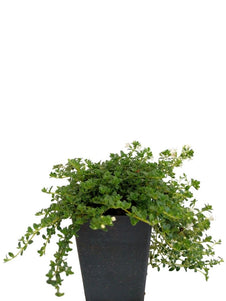







Thyme - White Creeping Thyme
Thyme - White Creeping Thyme

- In stock, ready to ship
- Inventory on the way

Usually available: All year
Life cycle: Perennial
Height: 3 - 8cm
Position: Full sun
Soil preference: Well drained
This is how we pack and send your Herb Plants to all states except TAS & WA
You will receive
- 1 White Creeping Thyme Herb Plant in a 50 X 75mm tube - General growing instructions
All of our Herb Plants are grown organically with certified organic potting mixes and fertilizers
Botanical Name: Thymus serpyllum 'Albus'
White creeping thyme is a variety of the wild creeping thyme, a perennial native to much of Europe and Northern Africa. It is very tolerant of the Australian environment, which is similar to its, often harsh, native Mediterranean climate. This hardy creeper and groundcover can tolerate some foot traffic and can be used as a ‘lawn’, around footpaths or in the rock garden. In summer, when it flowers the appearance is of a white carpet. The leaves are a grey-green oval shape and are held on stems up to 10 cm long. The flowers are strongly scented, as are the leaves which have been described as having a light lemon fragrance.
Thyme, generally, has appeared in writings over 3000 years old and the origin of the name is thought to be the Greek words ‘thumus’ for courage, or thymos, meaning ‘to perfume’. In its native environment, wild thyme is a great bee attractant and your own garden will also benefit from visiting bees.
Growing Conditions
White creeping thyme is a ground hugging plant, which grows to 5cm and spreads up to 50 cm. This plant loves the sun and can be planted in dry, exposed locations, including loose, sandy soil. It needs very little water and will die in heavy, damp soil. Thyme plants can become woody after a few years, so dividing or replanting with younger plants is a good idea. Propagation may be by seed, cuttings or dividing the roots. It will also grow well in containers if provided with a well drained soil mix.
Medicinal Uses
The active ingredient in thyme is thymol, which is a powerful antiseptic used in antiseptics and mouthwashes. Creeping thyme has similar medicinal properties to common thyme, but it is less potent. When the leaves are distilled, the many medicinal properties are the same, but to a lesser degree than in the creeping thyme.
Culinary Uses
Creeping thyme has a less distinctive taste that cultivated varieties, but is able to be used for cooking in the same manner as culinary varieties. Thyme is often used in a bouquet garni, tied together with other sprigs of fresh herbs, and left to simmer in dishes such as stews. Thyme helps to digest fatty foods and can be used with many meat and poultry dishes, egg and salad dishes.
Companion Plants
Cabbage, eggplant, salad burnet and strawberries all benefit from having thyme in the garden. Thyme attracts bees and other beneficial predator insects. Thyme is also thought to repel cabbage worms and flea beetles.
All information provided on this website is for informational purposes only. Please seek professional advice before commencing any treatment.





